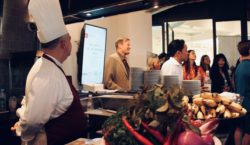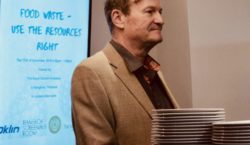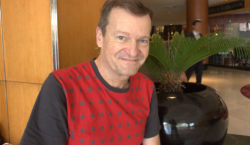
It’s 11.30 AM, and the four trucks are ready to leave the small garage and exit down the narrow alleyway in central Bangkok. The destination is set for supermarkets, restaurants and luxury hotels where leftover food is stocked in the trucks.
Once collected, all the food is brought to a receiver which include anything from poor communities to charities and shelters.
Every day, the drivers visit about 69 donor places combined. Each truck has a different receiver, which changes from day to day.
Keeping it cool
Today, it’s Tuesday, and a new recipient in South-Eastern Bangkok is receiving food from the Scholars of Sustenance (SOS) for the very first time.
It’s a normal day for the truck drivers, and it’s a normal day in Bangkok, where the outside temperature is 33 degrees with a humidity making it feel closer to 40.

But in the back of the truck, the temperature is kept at 2-4 degrees, so the food can keep cold and stay safe for consumption, when the destination is reached six-eight hours after leaving the garage.
Furthermore, all the drivers have taken a course in good food hygiene, so they can check that the food is fresh and edible before it is loaded.
Just because people are poor and it need of food, it doesn’t mean that they should be given trash, my driver explains.
A walk down memory lane
The founder of SOS Bo Holmgreen from Denmark is unfortunately out of town as he is currently expanding the project to the Indonesian island Bali. Instead, I meet with Bruce, the Programs Manager of SOS.
Bruce tells me the story of SOS from idea to realisation.
In relation to work, Bo Holmgreen had been staying in luxurious 5-star hotels neighbouring slum communities with poor sanitation, malnutrition and starvation. When eating at the hotel, Bo had started wondering “what happens to all the leftover food?”.
“It goes in the bin,” the answer from the hotels had been.
The interesting part, the Dane discovered, is that the hotels were happy to donate their food, but there was no system in place for such a transfer between donors and recipients.

Enter Bo Holmgreen and the birth of SOS about four years ago in 2016. Back then, the foundation typically gathered around 20 kg. of food per day. Today, that number has risen to about 1 ton on a regular day with each donor giving away 12-14 kg. of leftover food on average.
A domino effect
Since the beginning, more and more donors have joined the system in order to make sure their leftover food ends up in empty stomachs rather than in a full trash can.
But one thing the donors have worried about is their reputation. In general, they haven’t been thrilled about having leftovers associated with their name.
Thus, SOS has obligated itself to make sure the food is separated from the name of the donor.

I am personally confused as to why donors aren’t eager to splash their name all over such a project in a bid for promoting themselves as responsible corporations. But this has never been the driving force behind the system, quite the contrary in fact.
“A lot of people donated because it’s the right thing to do. The chefs believe, their food is good enough to eat,” Bruce explains.
So, the donors remained anonymous superheroes for those in need of food, and while they were enjoying leftovers from some of the best chefs in the country from upper class hotels, no one but the SOS team knew the sender of the colourful vegetables and juicy fruits.

This somewhat changed in 2017, when the supermarket chain Tesco Lotus went public with their donor status with SOS. It showed other donors, that it is ok to donate and to say it out loud.
“It had a domino effect on the programme, and more donors signed up,” Bruce explains.
There are however still a lot of donors that don’t want to be publicly associated with the programme, so unfortunately I am not allowed to take a photo of the map showing all the stops in Bangkok labelled with colourful post-its.
No fresh meat please
At the third stop, I recognise where we are. It’s one of my favourite restaurants in Bangkok. Only this time there is no need for a table reservation as we enter through the back to gather leftover bread and pastries for the recipient.
“Not many jobs offer the chance to see the back doors of five star hotels,” the driver jokes.
I am told, that SOS prefers proper food, but today croissants, doughnuts and other mouthwatering treats are plentiful. The majority of the food is however healthy, nutritious food ready to be reheated and served.
In the beginning people wondered if it was a safe system, but the foundation made a list of restrictions and offers all responsibility for the food once it leaves through the donors’ doors.

With this being said, the donors are given restrictions. Food must be edible and fresh, but raw meat and fish is not accepted, no coconut-based curries and no cooked rice or pasta include the SOS food regulations.
This is to ensure the safety of the food and as raw meat and fish can easily be spoiled, it is not allowed. Rice and pasta simply creates condense which makes it unpleasant to eat later. Just because recipients are grateful to get free food, there is no need to give them something, you wouldn’t eat yourself.
The dilemma of reducing waste
The other day I went to a rooftop bar, today I am entering the kitchen through the back door of that very hotel and helping bring boxes of food to the scale and then to the truck.
All the food is weighed so SOS knows how much food is gathered, and the donors know how much food they give away.

Bruce tells me that the data is used for research as it is collected and passed on. The donors use it for their own research.
Essentially this gives the donors a wake-up call of how much food they were wasting.
“So, they started reducing their waste. Of course that is good, but for us it means that the recipients get less food,” Bruce says.
But this is no problem for the recipient today. We deliver about 100 kilos of food for them, and they are overwhelmed. They had no idea, they were getting anything near that amount, so it takes some creativity to find the space for storing all the food.
About one and a half hours later, we leave behind some empty-handed donors and one happy recipient, and the driver is ready for a new day tomorrow.




